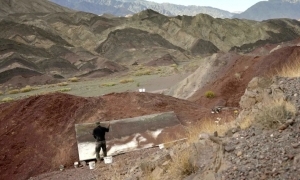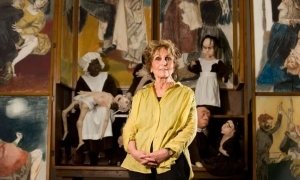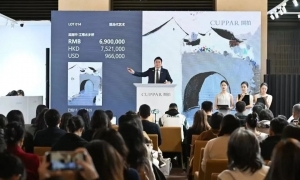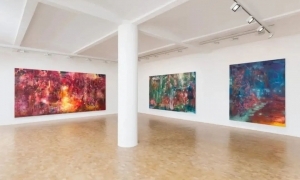王林
作為一位執(zhí)著的藝術(shù)家,傅榆翔喜歡帶有夢(mèng)魘感覺(jué)的圖象,我比較喜歡的作品是他的《樹(shù)妖》系列。在這些作品中,他找到了一種有意味的形式,把樹(shù)枝、樹(shù)根的造型和人體特別是女人體結(jié)合起來(lái),讓人覺(jué)得新鮮而富有詩(shī)意。這些圖象的來(lái)源和重慶的黃桷樹(shù)多少有些關(guān)系。黃桷樹(shù)作為重慶的市樹(shù),在巖壁暴露根系、盤(pán)根錯(cuò)節(jié)、枝繁葉茂,有非同尋常形態(tài)特征。傅榆翔利用有機(jī)體的相似性,創(chuàng)造出自己的繪畫(huà)形式,可見(jiàn)畫(huà)家平時(shí)用心良苦。
前言·于川美桃花山2004年5月15日
As a dedicated artist, Fu Yuxiang tends to produce those images that arouse a nightmare-like sensation, among which I personally like his Wood Sprite series. He has been able to find a form of meaning among his works by refreshingly and poetically combining the shapes of tree branches and roots with the form of female bodies. The source of these images more or less has a bearing with Ficus virens in Chongqing, which as the city tree of the municipality usually exposes its complicatedly twisted roots with intercrossing branches on the verge of cliffs, thus creating unusual morphological features. Having perceived the similarity of organisms, Fu Yuxiang successfully originated his own form of painting, which also reveals the artist’s commitment to his artistic creation.
From Wang Lin’s Preface,
written at Taohua Hill, Sichuan Academy of Fine Arts,
on May 15th, 2004
葉永青
傅榆翔的畫(huà)有著無(wú)盡的遼闊的蒼茫感,萬(wàn)物沉寂而各得其所,那是對(duì)生命自由的渴望與追求,他以藝術(shù)肯定對(duì)人間的“憐憫”,把生命價(jià)值置于藝術(shù)價(jià)值之上,換言之,他的藝術(shù)“價(jià)值”是在傳達(dá)對(duì)生命的態(tài)度與對(duì)人間的期許,亦即人灑脫飄逸的,生命是自由自在的,但是在飄逸、自由間,仍舊帶著由焦慮與不安轉(zhuǎn)化而來(lái)的無(wú)奈和感傷,而這些矛盾的因素現(xiàn)在已化為“凄迷的詩(shī)質(zhì)”,隱藏在他浪漫抒情的藝術(shù)風(fēng)格中。
凄迷的詩(shī)質(zhì)·2004年5月12日夜于山城桃花山
With a vast expanse of boundless infinity, Fu Yuxiang’s paintings reveal a quiet stillness of the creatures in their own proper place, reflecting an aspiration and pursuit of ultimate freedom. The artist with his works of art shows his “pity” on the world of mortals and places the value of life above that of the art. In another word, the artistic value is embodied by the delivery of artist’s attitude towards life and his expectation on the world of mortals, namely, the concept that humans are elegantly free and life is untrammeled. But in between there is still presence of palpable feelings of resignation and sorrow resulted from anxieties and worries. However, such contradictory factors have now melted into “poetic melancholy” hidden an artistic style of lyric romance.
From Ye Yongqing’s Poetic Melancholy,
written on Peach Blossom Mountain,
李小山
同時(shí)我覺(jué)得,傅榆翔在安排階段性任務(wù)時(shí)體現(xiàn)出來(lái)的總體觀顯得相當(dāng)成熟,這種成熟表現(xiàn)在腳踏實(shí)地的自我超越上,在這一過(guò)程中,沒(méi)有所謂的進(jìn)步和退步,它只是有意識(shí)并且有見(jiàn)識(shí)地推動(dòng)每一次超越。或許,傅榆翔還有更大程度的空間,那樣的話,他每一個(gè)階段的成果都是有力的見(jiàn)證。
傅榆翔曾使了很大的勁研究造型、色彩、用筆、肌理,做的工作已足夠了,從他的畫(huà)作里我們清晰地發(fā)覺(jué)了他這方面的全部?jī)?yōu)點(diǎn),豐富性和復(fù)雜性只在某種階段具有魄力,而尋找純粹的形式和表達(dá),則是衡量傅榆翔下一步創(chuàng)作尺度,缺少這個(gè),它的工作似乎才完成了一半,所以我說(shuō),他應(yīng)該建一座自己的橋,渡過(guò)去,完成全部過(guò)程。
建一座自己的橋·2004年9月3日于南京
Meanwhile, as I see it, Fu Yuxiang has demonstrated a mature capability of making an overall planning for periodic tasks. This type of maturity is manifested in a down-to-earth self-transcendence, during which process there is no such thing as so-called progress or retrogression but only a transcendence motivated by a well-informed self-consciousness. Perhaps there’s even more space for Fu Yuxiang’s artistic creation and in that case it will be witnessed by success of each stage.
Fu Yuxiang once made enhanced efforts and contributed sufficient work to the study of modeling, coloring, brushing and texture. From his works we can find a clear clue to all his strong points in this field. As richness and complexity are expression of vigorousness only at certain stage, the search of pure form and expression shall be regarded as the measurement of Fu Yuxiang’s creation at next stage. With this being absent, his work only seems half-done. Therefore, my comment would be he builds a bridge of his own and then cross over to complete the whole process.
From Li Xiaoshan’s Building A Bridge of His Own,
written in Nanjing,
on September 3rd, 2004
丁方
傅榆翔的畫(huà)帶有一種鮮明的文化地理的烙印,顯示了深闊的川蜀大地和蒼茫的群山對(duì)他心靈的影響;那些具有自然曠野氣息的元素彌漫在它的畫(huà)中,并構(gòu)成了傅榆翔的畫(huà)面的基本調(diào)性。實(shí)際上,描繪表現(xiàn)自然大地的畫(huà)家大有人在,但傅榆翔的畫(huà)面仍然令我驚異;因?yàn)樗鼘?duì)蘊(yùn)藏樹(shù)木自然中的原始生命力感受是如此強(qiáng)烈,對(duì)彌漫在大地山川中的詩(shī)意之體悟是如此濃郁,使我聞到了一種久違的氣息。
甘愿沉潛·2005年5月于北京
With a strong, vivid stamp of cultural geogrophy, Fu Yuxiang’s paintings demonstrate an influence of the vast land and rolling mountains in Sichuan on his soul; those elements with a natural touch of open fields present all over his works have constituted the basic tone of Fu Yuxiang’s own style. In fact, there’s a wide variety of painters who focus on the depiction of the great nature but the images created by Fu Yuxiang still come as a surprise to me because his feeling about life in its most primitive vitality contained in those trees and the nature is so intense and his perception of the poetic essence permeating through the vast expense of land and mountains is so overwhelming that I can even smell a long-lost connection.
From Ding Fang’s Chosen Quietness,
written in Beijing,
in May, 2005
宋智林
《樹(shù)妖》泛化地表現(xiàn)出人的一種生存狀態(tài),是實(shí)體生命與虛象運(yùn)勢(shì)的表述,但更準(zhǔn)確地說(shuō),它是“喜純、誠(chéng)摯與自由”的傳達(dá)。如若真實(shí)地達(dá)到這個(gè)狀態(tài),人就必須按照“生命的本來(lái)面目”去生活。在禪宗解釋中“生命的本來(lái)面目”指一種不經(jīng)意識(shí)浸染的,與無(wú)意識(shí)宇宙相通的狀態(tài)。也許,這正是傅榆翔先生欲借《樹(shù)妖》給人的一種深刻的思想啟示。
人文之元,肇自太極·2003年于北京
Wood Sprite expresses in general a state of existence for human beings and represents a combination of physical life and a virtual luck tendency. But more precisely, it conveys the concept of “purity, sincerity and freedom”. To truthfully reach this status, mankind will have to live as “the way it is”. According to the interpretation of Zen Buddhism, “the way it is” refers to a state in connection with the cosmos of unconsciousness, which is not interfered by the consciousness. This is perhaps the profound enlightenment that Mr. Fu Yuxiang wants to pass on to the viewers by his works of Wood Sprite.
From Song Zhilin’s Humanity Begins with Taiji,
written in Beijing,
in 2003
瑪格莉娜(意大利)
傅榆翔先生的杰作緣于觀察、理解和融入自然和社會(huì)氛圍,他見(jiàn)證了新藝術(shù)感性的發(fā)展。感謝人類(lèi)的共同語(yǔ)言:藝術(shù),傅榆翔先生,調(diào)和了不同文明的沖突,并成功的進(jìn)行了不同文化價(jià)值的對(duì)話。
傅先生,一陣來(lái)自中國(guó)的藝術(shù)清風(fēng)
依存身心的清風(fēng)·2004年5月13日于云南
The master pieces of Mr. Fu Yuxiang, a witness of the perceptible development of new art, are based on a shrewd observation, profound perception and a natural incorporation into the nature and social atmosphere. Thanks to art, the common language of mankind, Mr. Fu Yuxiang has brought different cultural conflicts into harmony and successfully conducted dialogues between different cultural values.
Mr. Fu, a breath of fresh air from Chinese art.
From Margarita(Italy)’s A Breath of Fresh Air from Mind and Soul
written in Yunnan
on May 13th, 2004
【編輯:霍春?!?/DIV>






















